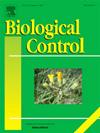Literature reviews narrow down where to search for agents for Urena lobata and Solanum torvum: Pantropical weeds with poorly defined native ranges
Abstract
It has long been recognized that surveys for candidate weed biocontrol agents should focus on the center of origin of the target weed species. Consequently, if the origin of a weed species is uncertain it can pose problems for biocontrol practitioners. This study focuses on Urena lobata and Solanum torvum, which are pantropical species that have become major introduced pasture weeds in Vanuatu where a biocontrol program to mitigate their impacts commenced in 2018. It was initially unclear where to survey for agents for both weed species due to conflicting information from a range of botanical resources regarding the original native ranges of these plants. For U. lobata it was not even obvious on what continents survey work should be conducted. Published literature and online databases were searched for host records of arthropods and plant pathogens associated with these plants to identify regions with the highest diversity of potentially host-specific natural enemies. This was coupled with very simple climate matching. Southeast Asia was identified as the most promising region to survey U. lobata and Central America and the Antilles the most promising regions to survey S. torvum. This case study indicates that there can be enough information online to enable internet sleuthing to significantly assist with targeting the survey stage of biocontrol programs against novel weed biocontrol targets of uncertain geographic origin.

 求助内容:
求助内容: 应助结果提醒方式:
应助结果提醒方式:


